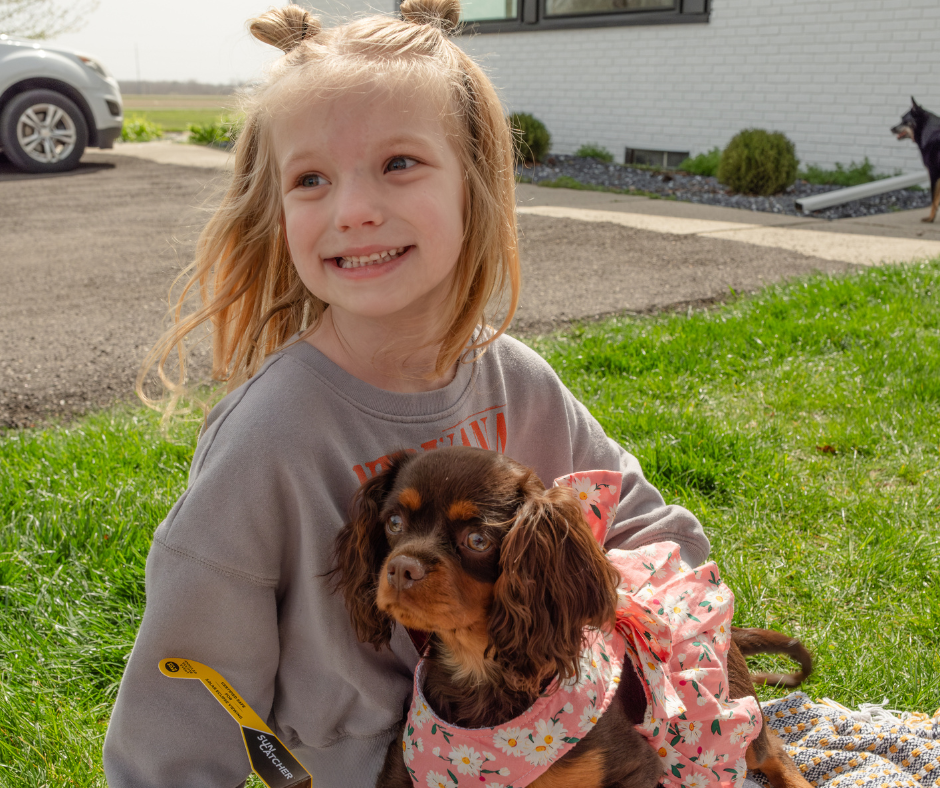Cavalier King Charles Spaniels have long been cherished as one of the most beloved and iconic dog breeds worldwide. With their endearing personalities, elegant appearance, and boundless affection, it's no wonder why they are a popular choice for pet owners. In this comprehensive guide, we will delve deep into the world of the Cavalier King Charles Spaniel, exploring their history, characteristics, care requirements, health concerns, and much more. If you are considering bringing a Cavalier King Charles Spaniel into your home or if you are already a proud owner of one, this guide will provide you with valuable insights and information to ensure a happy and healthy life for your furry friend.
Whether you're considering bringing one into your family or already have one as a cherished companion, this guide equips you with the knowledge needed to ensure a happy and healthy life for your furry friend. It's a must-read for anyone passionate about these delightful and affectionate dogs.
Historical Background of the Cavalier King Charles Spaniel
To truly understand the Cavalier King Charles Spaniel, we must first delve into their rich history. These dogs are named after King Charles II of England, who was known for his deep affection for the breed. Here is a brief overview of their historical background:
- Origins: The Cavalier King Charles Spaniel's roots trace back to the 17th century in England. They were initially bred from toy spaniels that were popular among British nobility. The breed's distinct look and personality traits began to take shape during this time.
- Royal Favor: During the reign of King Charles II in the 17th century, these dogs became a staple at the royal court. The king's fondness for them led to their association with the royal family, which eventually earned them the moniker "Cavalier King Charles Spaniel."
- Decline and Revival: Over time, the breed went through periods of decline and revival. In the late 19th century, breeders sought to recreate the original Cavalier King Charles Spaniel, which had evolved into a slightly different breed known as the English Toy Spaniel. This rejuvenation effort eventually led to the modern-day Cavalier King Charles Spaniel.
Breed Characteristics of the Cavalier King Charles Spaniel
Understanding the characteristics and traits of the Cavalier King Charles Spaniel is essential for prospective and current owners. Here are the key features that define this breed:
Size and Appearance of the Cavalier King Charles Spaniel
- Size: Cavalier King Charles Spaniels are small to medium-sized dogs. They typically weigh between 13 to 18 pounds (6 to 8 kilograms) and stand about 12 to 13 inches (30 to 33 centimeters) tall at the shoulder.
- Coat: Their silky, smooth coat is a hallmark feature of the breed. Coat colors can vary, including Blenheim (chestnut and white), Tricolor (black, white, and tan), Black and Tan, and Ruby (solid chestnut).
- Face: They have expressive, large, dark eyes and a distinctive, well-defined snout with a black nose.
What is the Temperament of the Cavalier King Charles Spaniel Like?
Cavalier King Charles Spaniels are renowned for their wonderful temperament and charming personality. They possess several traits that make them excellent companions:
- Affectionate: These dogs are incredibly affectionate and thrive on human interaction. They are known for forming strong bonds with their owners and are often described as "velcro dogs" due to their desire to be close to their loved ones.
- Gentle: Cavaliers are gentle and good with children and other pets, making them a great choice for families.
- Sociable: They are sociable by nature and enjoy meeting new people and other dogs. This makes them excellent pets for those who lead active social lives.
- Playful: Despite their regal appearance, Cavaliers are playful and enjoy interactive playtime with their owners.
- Intelligent: They are intelligent and eager to please, making them relatively easy to train with positive reinforcement techniques.
How Much Exercise Does the Cavalier King Charles Spaniel Need?
While they may be small, Cavalier King Charles Spaniels are active dogs that require regular exercise to stay healthy and happy. Here are some exercise considerations:
- Daily Walks: A daily walk is essential to meet their exercise needs. Aim for at least 30 minutes to an hour of brisk walking or playtime.
- Playful Activities: Engaging in playful activities such as fetch or interactive toys can help burn off excess energy.
- Mental Stimulation: Mental stimulation through puzzle toys or obedience training can keep them mentally sharp.
What are the Grooming Requirements for the Cavalier King Charles Spaniel?
Cavalier King Charles Spaniels have a luxurious coat that requires regular grooming to keep it in top condition:
- Brushing: Brush their coat at least a few times a week to prevent matting and remove loose hair.
- Bathing: They do not require frequent baths, typically only when they get visibly dirty or smelly.
- Ears: Check their ears regularly for signs of infection or excessive wax buildup.
- Nails: Trim their nails as needed to prevent overgrowth.
Health Considerations
Like all breeds, Cavalier King Charles Spaniels are prone to specific health issues. Being aware of these concerns can help you provide the best possible care for your furry companion:
- Heart Disease: One of the most prevalent health issues in this breed is mitral valve disease (MVD). This condition affects the heart valves, leading to heart failure. Regular veterinary check-ups and early detection are crucial for managing this condition.
- Syringomyelia: Syringomyelia is a painful condition where fluid-filled cavities develop in the spinal cord. It is common in Cavaliers due to their unique skull shape. Signs of syringomyelia can include scratching, head tilting, and neck pain.
- Eye Problems: Cavaliers are susceptible to various eye conditions, including cataracts, retinal problems, and dry eye. Regular eye examinations by a veterinarian can help detect and manage these issues.
- Ear Infections: Their floppy ears can trap moisture and debris, making them prone to ear infections. Cleaning their ears regularly and keeping them dry can help prevent infections.
- Hip Dysplasia: Although less common than in larger breeds, hip dysplasia can occur in Cavaliers. Regular exercise, a balanced diet, and maintaining a healthy weight can help reduce the risk of this condition.
Training and Socialization for the Cavalier King Charles Spaniel
Training and socialization are crucial aspects of raising a well-behaved Cavalier King Charles Spaniel. Here are some tips for effective training:
- Positive Reinforcement: Use positive reinforcement techniques, such as treats and praise, to motivate and reward good behavior.
- Socialization: Expose your Cavalier to various people, animals, and environments from a young age to promote socialization and reduce anxiety.
- Obedience Training: Basic obedience training, including commands like sit, stay, and come, is essential for safety and a well-behaved pet.
- Consistency: Be consistent in your training approach and routines to avoid confusion.
What are the Nutrition and Diet Requirements for the Cavalier King Charles Spaniel?
A balanced diet is essential for your Cavalier King Charles Spaniel's overall health. Consult your veterinarian for specific dietary recommendations, but here are some general guidelines:
- High-Quality Dog Food: Choose a high-quality dog food appropriate for their age, size, and activity level.
- Portion Control: Avoid overfeeding and follow the recommended portion sizes to maintain a healthy weight.
- Fresh Water: Ensure they have access to clean, fresh water at all times.
- Treats: Use treats in moderation, as excessive treats can lead to weight gain.
Do Cavalier King Charles Spaniels Need Exercise and Mental Stimulation?
Cavaliers require both physical and mental stimulation to stay happy and healthy. Here are some activities to keep them engaged:
- Daily Walks: Regular walks provide exercise and mental stimulation as they explore new scents and sights.
- Playtime: Interactive play sessions with toys or games like fetch can be a great way to burn off energy.
- Puzzle Toys: Consider using puzzle toys to challenge their intellect and keep them occupied.
- Training: Obedience training sessions can provide mental stimulation and strengthen the bond between you and your pet.
Traveling with Your Cavalier
Cavalier King Charles Spaniels can make great travel companions. Here are some tips for traveling with your furry friend:
- Safety First: Ensure your pet is safely secured in a carrier or with a seatbelt harness when traveling in a car.
- Comfort: Pack essentials such as food, water, a leash, and familiar bedding to make your pet feel comfortable during the journey.
- Air Travel: If flying with your Cavalier, check airline regulations and requirements for pet travel in advance.
The Cavalier King Charles Spaniel is a delightful breed known for its charming personality, elegant appearance, and unwavering affection for its owners. Understanding their history, characteristics, and care requirements is essential for providing them with a happy and fulfilling life. By addressing their unique health considerations, investing time in training and socialization, and maintaining a balanced diet and exercise routine, you can ensure that your Cavalier King Charles Spaniel thrives as a beloved member of your family. In return, you'll receive a lifetime of loyalty, companionship, and love from your furry friend.
In this Ultimate Cavalier King Charles Breed Guide 2024, we've covered a wide range of topics, from the breed's history to their temperament, health concerns, and care guidelines. Armed with this knowledge, you'll be well-prepared to provide the best possible life for your beloved Cavalier King Charles Spaniel.

